Credit & Copyright: STS-9 Crew,
NASA
Explanation:
The
Manicouagan Crater
in northern
Canada
is one of the oldest
impact
craters known.
Formed during a surely
tremendous impact
about 200 million years ago, the present day terrain supports
a 70-kilometer diameter
hydroelectric
reservoir in the telltale form of an
annular lake.
The crater itself has been worn away by the passing
of
glaciers and other erosional processes.
Still, the hard
rock at
the impact site has preserved much of the
complex impact structure
and so allows scientists a leading case to help understand
large impact
features on Earth and
other Solar System bodies.
Also
visible above
is the vertical fin of the
Space Shuttle Columbia
from which the picture was taken in 1983.
1999 2000 2001 2002 2003 2004 2005 2006 2007 2008 2009 2010 2011 2012 2013 2014 2015 2016 2017 2018 2019 2020 2021 2022 2023 2024 2025 |
Yanvar' Fevral' Mart Aprel' Mai Iyun' Iyul' Avgust Sentyabr' Oktyabr' Noyabr' Dekabr' |
NASA Web Site Statements, Warnings, and Disclaimers
NASA Official: Jay Norris. Specific rights apply.
A service of: LHEA at NASA / GSFC
& Michigan Tech. U.
|
Publikacii s klyuchevymi slovami:
krater - crater - Earth - Manicouagan crater - impact crater - impact - Zemlya - krater Manikuagan
Publikacii so slovami: krater - crater - Earth - Manicouagan crater - impact crater - impact - Zemlya - krater Manikuagan | |
Sm. takzhe:
Vse publikacii na tu zhe temu >> | |
